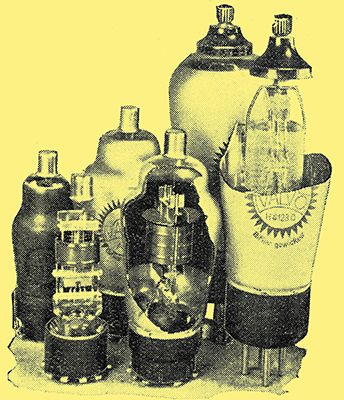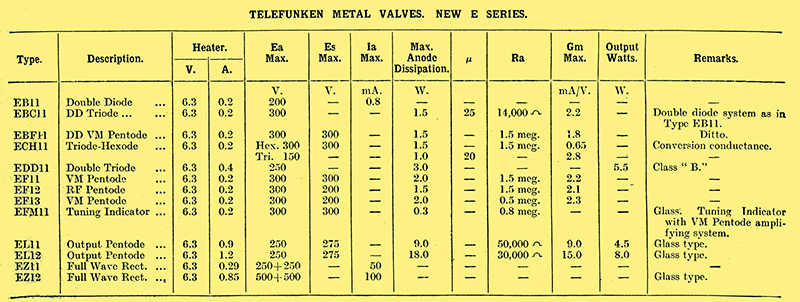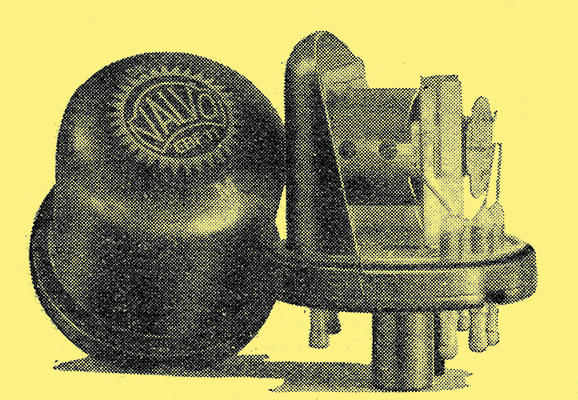|
This article explains how the new German metal valves differ from their American prototypes. It is also shown how the extremely low cost of the 'Small Peoplebs Receiver' is partly accounted for by a specially designed detector-output double-valve and low-power rectifier.

A comparison in size between valves of the new 'Red' series (left) and existing German types.
For economic and other reasons only a few new valves are to be issued in Germany this year to extend existing ranges. The various valve manufacturers marketing their products in Germany have for some time past worked in close co-operation, and the multiplicity of valve types, so familiar in England, is not known there.
The chief innovation is the range of metal valves of the new E series to be manufactured by Telefunken, Philips, and Tungsram. The complete series consists of thirteen types, of which nine are of metal construction and the remaining four are provided with glass bulbs. Of the four glass types, one is a tuning indicator, two are output pentodes, and one is a high-tension rectifier. The difficulty of obtain- adequate heat radiation from the output pentodes and the rectifier has been circumvented by providing them with glass envelopes instead of metal.
The range has been named the Harmonic Series (for reasons which are not very clear), and all types are fitted with a new eight-pin base, which is provided with a spigot after the principle of the octal base. The pins are arranged in two of five and three pins each respectively and are so connected as to isolate much as possible the grid lead from the heater leads and also from the anode lead. When the special socket is mounted on the chassis a small metal screen is fastened in position on the under side of the chassis so as to screen the two groups of connecting wires from one another.
While these metal valves are very similar in construction to the American metal valves, the former embody differences in design which are worthy of note, and are stressed in Germany as constituting major improvements.
The electrode systems in the metal types, instead of being vertical, are all mounted horizontally, and this accounts for the greater diameter of the metal shell compared with the American types, but it enables a reduction in height to be effected.
The horizontal disposition of the electrodes makes it possible to support both ends of the complete structure from small metal angle brackets which are welded to the base plate, It is claimed, and probably with some justification, that this method of construction reduces microphonic noise. Since the electrodes are rigidly supported and are short in length it is possible to reduce the inter-electrode clearances, which results in the valves having an improved performance. For example, the clearance between the cathode and the first grid has in some cases been reduced from 0.4 mm. to 0.23 mm. The short length of the cathode also enables a heater to be used which consumes about 1.25 Watt, as compared with 2.5 Watts in similar glass types.
This feature of short electrode length is rather unusual, and considerable ingenuity must have been exercised in the design of the multiple types, such as the triode-hexode, employing a common cathode.
Top grid connections have been entirely dispensed with in this series, and it is maintained that this enables a simplification in design and construction of sets to be achieved, together with a reduction in the length of 'hot' leads to the grids. The practice of bringing out all electrode leads through the base seems to be finding favour both in America and Germany.
It is interesting to note that this range of metal valves is not to be produced in large quantity at first, as such an undertaking might disorganise production of other valve types. It is proposed at present that these valves be fitted only to receiving sets selling for more than Rm 285 (about £25), but that their use will be extended to cheaper receivers as time goes on.
A table giving technical details of these metal valves is given below.

Among the new glass valves are two interesting types which have been specially designed for use in the new Deutscher Kleinempfanger or Small Peoplebs Receiver, already mentioned in The Wireless World. This receiver sells for Rm 35 (about £2 18s.) and is fitted with valves of Types VCL11 and VY2. The first valve is a combination of a high-amplification triode and an output tetrode, and the second is a small half-wave rectifier for the HT supply. The heater of the VCL11. is rated at 90 V, 0.05 A, and that of the VY2 at 30 V, 0.05 A.
The design of both portions of the VCL11 has been carefully worked out so that the triode part will, on an average signal, give an adequate output for the tetrode without recourse being had to transformer coupling which is not embodied in the receiver on account of expense. The amplification factor of the triode is about 65.
The tetrode has been designed to have a high mutual conductance, actually 5 mA/V, and gives an output of 0.8 W with 3 V input.
The electrodes of this double valve are mounted vertically one above the other with a common cathode, the small triode portion being at the top.
The rectifier is of very small dimensions and in appearance somewhat resembles a small detector diode such as is used in this country. The maximum rectified current that it is rated to supply is 25 mA.
It is understood that it is largely due to the design of these two valves, not only from the point of view of circuit simplification, but also from economy of production, that the Small People's Receiver has been produced at such a low price.

A double-diode VM pentode in the new metal series. Note the horizontal arrangement of the electrodes in the cut-away view.
|